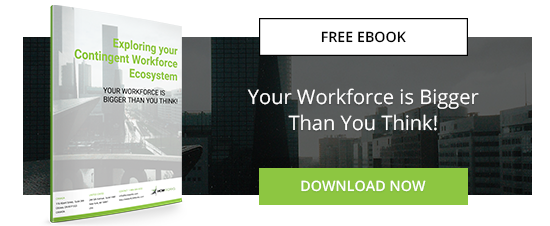Companies are using a myriad of methods to develop and enrich their workforces across the supply chain, and in today’s on-demand economy (ODE) this is becoming the norm. Businesses now rely heavily on both their own internal workforce, and a contingent or external workforce.
"The gig economy...is now estimated to be about 34% of the workforce and expected to be 43% by the year 2020," Intuit (INTU) CEO Brad Smith said in an interview with CNNMoney.
With the increased reliance on contingent workers, whom are normally sourced departmentally and not centrally (without the involvement of HR), there comes complex HR labor taxes and legal issues if not handled correctly. It’s because of this disconnect with HR that those responsible for talent management, and labor, don’t always have a clear understanding or visibility of the entire workforce.
There is a huge range of benefits that companies look to achieve by making use of external workers and/or implementing a contingent workforce program.
And despite the monumental increase in contingent labor over the last decade, the majority of businesses do not have processes or policies in place to ensure complete compliance with general labor and legislative regulations. Knowing these risks and being aware of them is crucial to helping ensure appropriate compliance measures are in place to avoid liability and still benefit from the external workforce.
Here are 14 benefits that can be realized from participating in the gig economy:
- Top talent on a project basis
- The worker will normally use their own equipment
- No dismissal protection
- Less direct and non-wage labor costs
- More flexibility
- No continued remuneration
- Increase competitive advantage
- Reduced management time on salary discussions/performance evaluations
- No social security contributions
- Lower impact on works council issues
- Reduced HR fixed costs
- Lower employee headcount
- Business growth and continuity
- Fill skill gaps in your company
Four Contingent Workforce Strategies
Your contingent labor program will most likely differ from your competitors, and any other company for that matter, each will be unique to fit the needs of the organization. Despite the differences, it is important for all organizations to consider solutions that include the following four key strategies.
First, think big picture and envision a contingent workforce strategy that makes sense with your organization’s mission and values, including how it will relate to external partnerships.
Second, establish a clear set of guidelines and rules focusing around outsourcing and considering both domestic and international norms (if applicable). This will mean that you have a stringent baseline of how the external sourcing should be handled, and anyone involved will have a reference to understand the process.
Third, your company will want to monitor your compliance with regular audits of your business processes. This makes sure you are not exposed to any legal issues, and keeps partnerships up to date.
Fourth, make sure you involve your legal and human resources teams from the start, to ensure they know about your contingent workforce and have a good visibility of the situation.
Effective contingent workforce management is an important issue for organizations to address, both on the operational side and the human resources side. Companies who utilize contingent workforces correctly will reap the benefits, lower their costs and develop a new competitive advantage.
HCMWorks are experts in contingent workforce management and advisory. We would be happy to discuss your company’s unique contingent needs and work with you to create the best solutions for you, to speak to one of our contingent workforce advisors click here.



